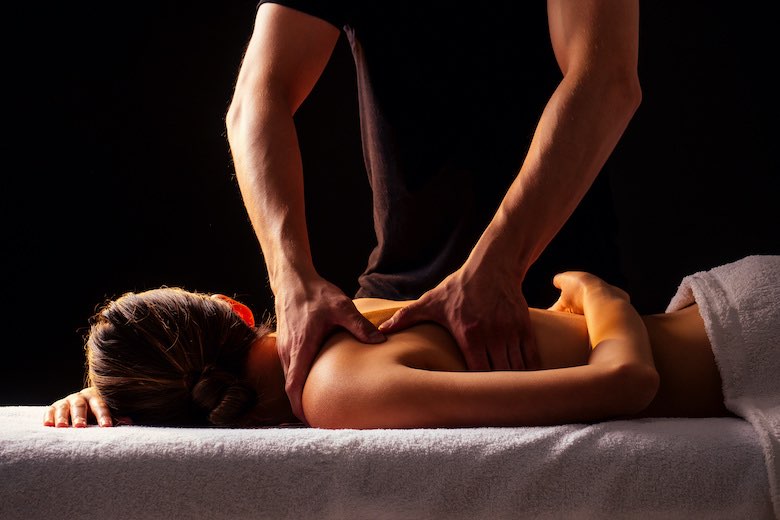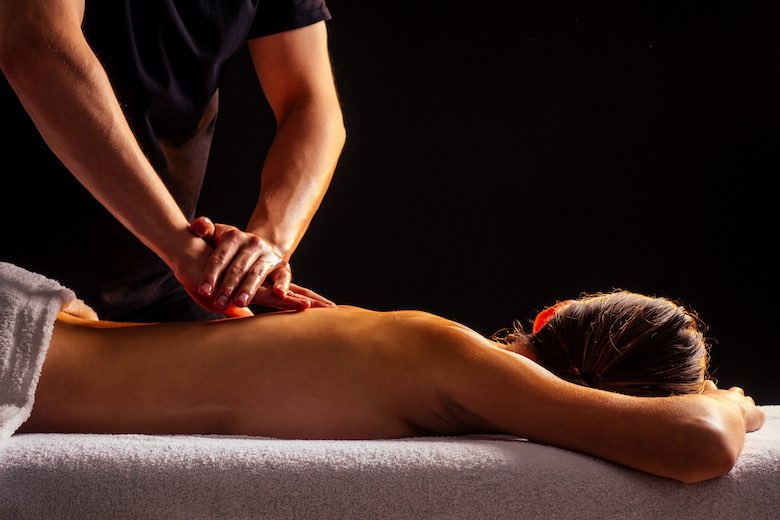


Massage is the practice of stroking, kneading or rubbing of the skin and underlying soft tissues ( muscles, tendons, ligaments and fascia) to promote healing and improve overall well-being.
Massage therapists typically use their hands to apply gentle or intense pressure to the body. However, forearms, elbows, knees and legs sometimes come in handy to reduce body strain, pain and muscle tension.
The body responds to massage in two ways – emotional and physical:
Massage therapy is increasingly being offered along with standard treatment of a wide range of medical conditions, including:
Despite its benefits, massage is not a replacement for regular medical treatment. Make sure you consult your primary care physician first before using massage therapy to treat any health condition.
With more than 250 variations of massage and bodywork techniques available around the world, choosing the right one can get a bit overwhelming. Below we look at some of the most common forms of massage in Australia to help you understand which one might suit your needs best.
Acupressure
Acupressure is a massage technique for applying pressure on the body’s acupoints (meridians) to treat various ailments. According to Traditional Chinese Medicine (TCM), it helps release the so-called “qi” (pronounced “chee”) – vital life force or energy – to allow it to flow freely throughout the body.
Aromatherapy Massage
Aromatherapy massages combine gentle pressure with the use of essential oils made of selected flowers and plants to facilitate mental stimulation. Different aromas can relax the body, soothe the mind, reduce stress, boost energy or promote happiness and emotional well-being
Chinese Massage
Chinese massage or Tui na focuses on promoting the life force flow (qi) and improving overall health. Its primary goals include increasing circulation and reducing muscle tension with kneading, twisting and pulling techniques.
Couples Massage
A couples massage is a session for romantic partners, but friends and family members also choose it to enjoy a relaxing experience together. Each has a separate massage therapist and table and can pick a different massage, depending on their needs and preferences.
Deep Tissue Massage
Deep tissue massage uses slow strokes and firm pressure to target the deeper layers of the muscles and fascia (the connective tissue surrounding the muscles). It helps break up scar tissue that forms following an injury and breaks down muscle knots to reduce inflammation and muscle tension. Deep tissue massage is an umbrella term describing many massage therapies (e.g sports massage or lymphatic drainage) and occurs in some form in many massage treatments.
Hot Stone Massage
Hot stone massage involves placing basalt volcanic rocks known to retain heat on various body parts. The rocks are heated before treatment and then used during massage to apply deeper pressure to body areas of concern without causing any discomfort. Hot stone massage aims to promote relaxation, reduce inflammation and ease muscle tension.
Acupressure
Acupressure is a massage technique for applying pressure on the body’s acupoints (meridians) to treat various ailments. According to Traditional Chinese Medicine (TCM), it helps release the so-called “qi” (pronounced “chee”) – vital life force or energy – to allow it to flow freely throughout the body.
Aromatherapy Massage
Aromatherapy massages combine gentle pressure with the use of essential oils made of selected flowers and plants to facilitate mental stimulation. Different aromas can relax the body, soothe the mind, reduce stress, boost energy or promote happiness and emotional well-being
Chinese Massage
Chinese massage or Tui na focuses on promoting the life force flow (qi) and improving overall health. Its primary goals include increasing circulation and reducing muscle tension with kneading, twisting and pulling techniques.
Couples Massage
A couples massage is a session for romantic partners, but friends and family members also choose it to enjoy a relaxing experience together. Each has a separate massage therapist and table and can pick a different massage, depending on their needs and preferences.
Deep Tissue Massage
Deep tissue massage uses slow strokes and firm pressure to target the deeper layers of the muscles and fascia (the connective tissue surrounding the muscles). It helps break up scar tissue that forms following an injury and breaks down muscle knots to reduce inflammation and muscle tension. Deep tissue massage is an umbrella term describing many massage therapies (e.g sports massage or lymphatic drainage) and occurs in some form in many massage treatments.
Hot Stone Massage
Hot stone massage involves placing basalt volcanic rocks known to retain heat on various body parts. The rocks are heated before treatment and then used during massage to apply deeper pressure to body areas of concern without causing any discomfort. Hot stone massage aims to promote relaxation, reduce inflammation and ease muscle tension.
Indian Massage
Indian head massage releases tension in the head, neck and shoulder area. It involves various techniques, including acupressure, to improve blood flow and is used to treat fatigue, headaches, insomnia and sinusitis.
Infant Massage
Infant or baby massage can help treat constipation, colic and sleeping problems with babies. Regular gentle massage has proven to help premature babies gain weight at a faster rate.
Lomi Lomi Massage
Hawaiian or Lomi Lomi massage helps improve blood flow, ease tense muscles and detoxify the body through various stroking techniques and nut oils. The gentle, fluid, rhythmical strokes emulating ocean waves help the body to let go of its old behaviours and promote emotional healing.
Lymphatic Drainage
Lymphatic drainage massage helps improve lymphatic flow and blood circulation, enabling the body to remove toxic waste and deliver healthy nutrients to its entire system. Manual lymphatic drainage is often used to reduce fluid retention in the legs or arms, body weight and cellulite accumulation as well as treat conditions such as lymphoedema, fibromyalgia, arthritis and many more.
Myofascial Release
Myofascial release focuses on relieving pain in your myofascial tissues - the thick connective tissues that support your muscles and organs. During a myofascial release massage, your therapist spends time feeling your myofascial tissue for areas that are particularly stiff and tight which causes the pain. They will massage and stretch the myofascial tissue and eliminate knots. Myofascial release therapy is often intense and painful and you may feel sore immediately after, but ultimately it will reduce pain and stiffness and increase muscle mobility.
Myotherapy
Myotherapy is used to prevent or treat soft tissue pain and restricted joint movement caused by muscle or muscle fascia (myofascia) dysfunction. It can include acupressure, trigger point therapy, myofascial dry needling and other techniques to restore the healthy function of the muscles, tendons, ligaments, fascia and joints.
Pregnancy Massage
Pregnancy or prenatal massage is used to ease stress, reduce swelling in the arms and legs and alleviate muscle and joint pain in pregnant women. It is designed to ease their discomfort at a time when they cannot use medicine and prepare their bodies for labour.
Reflexology
Reflexology massage uses gentle to firm pressure on specific points of the feet, hands and ears that correspond to various body parts. Pressure applied to those areas is believed to bring relaxation and healing to the corresponding area of the body and improve overall well-being. Reflexology massage is a good option for people who do not feel comfortable being touched on the entire body.
Relaxation Massage
Relaxation massage helps refresh the entire body, from soothing muscles and improving blood flow to calming the mind and rejuvenating the skin. It uses long flowing strokes and gentle kneading techniques to destress and relax the body and mind.
Remedial Massage
Remedial massage aims to "remedy" the body's normal functions following an injury or an illness. It eliminates muscle knots, restores joint mobility and improves blood flow. Remedial massage is focused on relieving pain as opposed to relaxation massage which is intended to be soothing.
Shiatsu Massage
Shiatsu is a Japanese massage which as many similar Asian massage styles was developed to unblock the qi, the vital energy that travels through the body. Your therapist might use their hands, thumbs or even elbows and knees, to deliver pressure and stimulate the energy channels (known as the meridians) and thus unblock any stuck energy. In turn, this allows the body to heal itself.
Sports Massage
Sports massage aims to reduce the stress and tension that build up in the soft tissues during exercise. It is beneficial to anyone who exercises to increase flexibility, prevent injuries or help the healing process after a sports injury. Sports massage can be often strenuous and involves deep, intense techniques to restore mobility to an injured muscle.
Swedish Massage
Swedish massage is what you would consider a "typical" massage. It uses five main techniques - stroking, kneading, rubbing, rhythmic tapping and vibration. This form of massage is designed to improve circulation and is perfect for first-timers looking to improve physical or emotional well-being.
Thai Massage
Thai massage originates from India and unlike other Western massage techniques does not involve lying on a massage bed. Instead, the client lies fully clothed on the floor and participates more actively in the massage. Thai massage is often referred to as assisted yoga where the therapist will stretch and twist you into various positions to relieve tension, promote relaxation and improve flexibility.
Therapeutic Massage
Therapeutic massage involves gentle kneading of the muscles with no discomfort to improve circulation, destress and calm the nervous system. It is beneficial for people who are highly stressed or those who need "touch therapy" and comfort ( e.g dementia sufferers.). Therapeutic massage can also help people with Multiple Sclerosis, Parkinson's Disease or those sensitive to pressure such as elderly people.
Trigger Point Massage
Trigger point therapy focuses on muscle knots (due to a chronic condition or injury) that cause radiating pain in soft tissues, joints and bones. There are a number of ways to release a trigger point - pressure with fingers, thumb, elbow or a massage ball. Your therapist might also use a combination of dry needling, stretching, heat and massage to reduce the irritation caused by the trigger point.

The cost of a massage in Australia primarily depends on the treatment type, massage therapist’s expertise and experience and location. For instance, New South Wales and Victoria have the highest average prices, with some sessions reaching $300.
The median massage prices in Australia range from $45 for 30 minutes to $160 for a 90-minute session, but some treatments are more expensive.
For instance, a massage for pregnant women and a sports massage can reach $190 per hour or session.
Browse our directory to compare various treatments’ prices across Australia and choose the best massage therapist for your needs.

Whether you visit a massage spa, parlour, lounge or hire an independent massage therapist, you can expect a relaxing atmosphere tailored to your needs. For instance, you can choose calming music and scented candles to soothe your mind and body.
You will lie on a massage table for most treatments, while others will require a mat (e.g.Thai massage) or a chair. Your therapist will probably use lotions or essential oils to relax you with the aromas and ensure smooth gliding strokes and movements on the skin.
Some sessions can last as short as 10-20 minutes (typically chair massages), while others require more time – usually 30, 60 or 90 minutes. It depends on the treatment and your preferences.
Explore our massage therapists’ listings to learn more about their services and understand what you can expect from a session.
MassageMyBodyaustralia is your leading wellness partner in finding the best massage nearby. Our vast directory features thousands of professionals passionate about helping people feel better and enjoying life to the fullest.
Choose your city below to find top massage therapists nearby specialising in your desired technique.